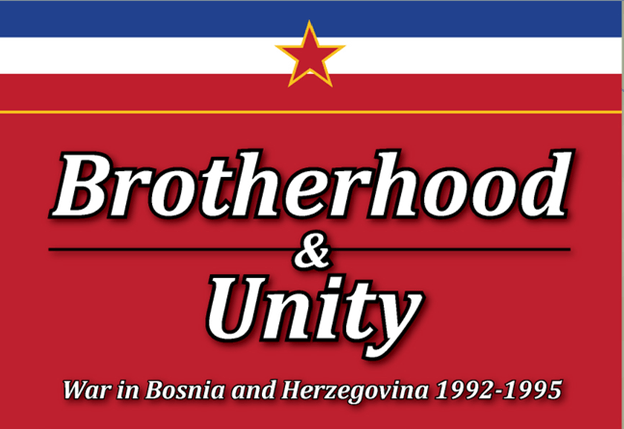
Greetings fellow gamers from the MidAtlantic; my name is Barry Setser and I’d liked to share with you details about this great upcoming title from Compass Games called “Brotherhood & Unity”. The game is on a subject rarely covered in the gaming world – the Bosnian War in 92-95. The title is a popular slogan used in the days of Tito to create unity in the bewildering hodgepodge of ethnic groups in the country formerly known as Yugoslavia. Former, yes and this game covers the most significant conflict from the post Tito wars.
My interest in the title is two-fold: first, my last military deployment was to Tuzla in 96 as part of the first US peacekeepers in Bosnia. Got to read a bit while I was there about the conflict and see some of the areas first hand. It is inevitable as a gamer that I’d be drawn to a title about a war I caught the tale end of.
Secondly, the title was the same name I’d chosen for a work I’m ever so slowly putting on about WW2 Yugoslavia. Got lots of congratulations about my upcoming title; nope, not me, but clearly a designer who knows his stuff. I did speak with Tomislav a few times about his game and he offered to help a bit with my work as it comes into shape. We’re here to talk about his game, so time to break out some chits and let the dice roll!
What makes this game so compelling? The first hook is that B&U is one of the few three player games in the market! The sides are the Serbians, the Croats and the Bosniaks; it’s a three-for-all at game’s beginning. Nowhere in the rule book are there any rules compelling the sides to work together. Actually asked Tomislav about this very point and his reply was very concise, “Let the players figure it out!” OK, but still? Serbia is easily the heavy in this game and they could overwhelm the two other powers (except for some tortured terrain and pesky Event cards):
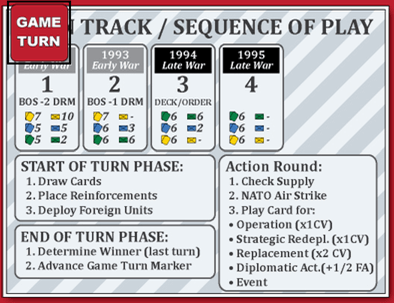
More cards, more troops and the Bosniaks start off in a big hole capabilities-wise with a crippling -2 DRM to their combat rolls. Plus (historically), the Croats and Bosniaks had an ongoing relationship which in the game shows up with Bosnia using Croatian supply sources! (Tomislav IS Croatian, so not questioning his research on this point). Simply, if the Croats and Bosniaks do not work together, they will likely lose. Yes, let the players figure it out.
The best attractor to the game is that it is very much cut from the Paths of Glory line of games (PoG, Pursuit of Glory, Illusions of Glory, Triumph of Chaos, Shifting Sands, et al.) If you know how to play these games (which most of the readers here will), then you’ll have little problem sinking into this gem.

It’s card driven, play cards for Ops pts or Events and spend the Ops for moving, attacking, SR’ing and reinforcements – all straight from PoG. A few other PoG related notes – this game has way less chrome bits than the series norm; in fact there’s really only 2 chromey bits that I’ll dig into more detail later – foreign attitude and the geography of what regions each side has to control for the win. In all other areas, the game has been greatly simplified. The combat charts for example:
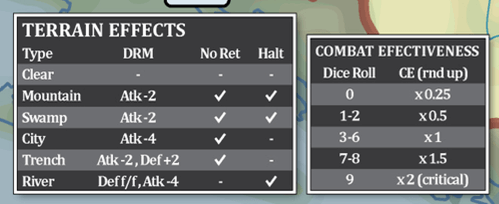
Combat is resolved in a single die roll by each side with terrain DRMs (modifies your Combat Effectiveness roll) and combat card play. You multiply your combat value (1st number on counter) by the effectiveness roll and generate loss factors to hit your opponent with. The middle number on the unit counter is the Loss Factor (normal PoG fare). That’s it, very simple and elegant; one of the easiest combat systems I’ve ever seen.
Sample combat:
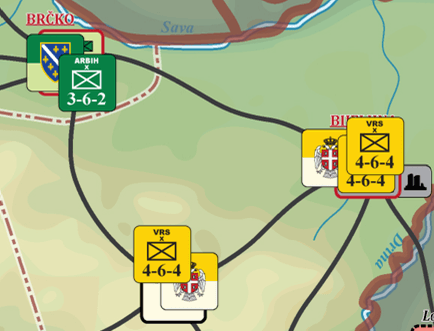
The 2 Serbian spaces will activate to attack the Bosniak unit. No terrain DRMs apply here for the attack, so rolling up the battle. If the Serbs get a 3 or higher on their combat effectiveness roll, the Bosniaks are destroyed as they can take a total of 12 losses (the reverse side also has 6 loss factors). The defenders only inflict damage if they roll a 9 for combat effectiveness which doubles their strength in combat. In order to damage units you have to achieve at least as many hits as the lowest loss factor and any remaining factors are dropped. Note that if this battle took place in the first two turns of the game, the Bosniaks would have no chance as they have -2 turn 1 and -1 turn 2 for their combat rolls (see Sequence of Play above). That’s it; no CRT, no odds calculations. I’d consider this the opposite of chrome as far as game design goes.
Onward to the two more unique portions of the game:
Foreign Attitude
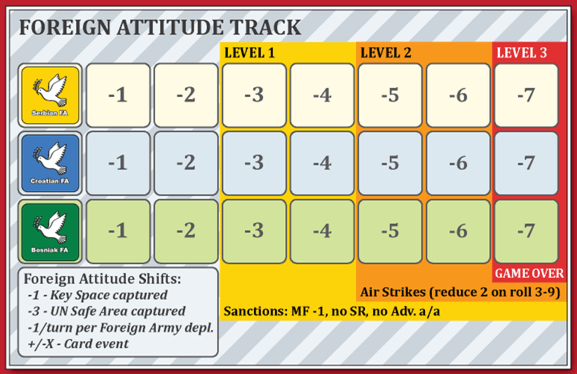
One of the most distinguishing features of the conflict was the desire to win the war for your side, but without attracting the attention of the foreign powers. That IS how the real war ended, attracting the attention of powers outside of the Balkans! Anything that nudges you towards victory has an effect on Foreign Attitude (FA track shown above). The more you clobber your opponent (Serbia initially), the more likely the UN will hit you with sanctions, and as the sanctions stiffen, the larger the affects on your campaign will be. Thumb your nose long enough at the foreign powers, they intervene to end you war for you. So one must tread carefully along the path of foreign opinion.
The way you lessen the FA is by Event card play, or by playing Ops card towards notching the attitude down a step by any card play, or place a 4 Ops cards to improve by 2 steps. A bit of a clarification I just noticed – this chart shows negative numbers, so to improve you FA status you actually increase by 1 or more steps (move closer to zero). Says it on that Event card in the image above! Not to hard to grasp, and certainly sets limits on what amount of chaos you can sow.
That Bosnian Geography
Now for the hardest part of the game to wrap your head around – the geography. The political and ethnic divisions in Bosnia Herzegovina is a dizzying patchwork of peoples scattered across the area. Compounding the issue further is that few people have much familiarity with the area at all; it’s not like the game is in Stalingrad where many of us know of the Tractor Factory, or Pavlov’s House. Control of specific terrain is the key towards your side winning the game, so the players will need to heavily lean on the Player Aids that highlight the geography you need to care about. A bit more detail:
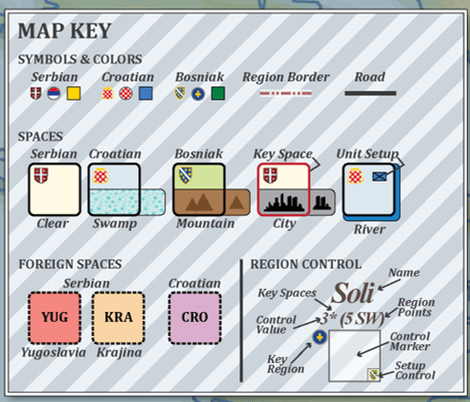
Pay attention to the Map Key and the symbols for the side you are playing. The Key regions you need will have your symbol on them; looking at Soli (above), this is a key Bosniak Region (yellow cross in blue circle). It also starts in Bosniak control (lower right corner). The Strategic Will (SW) points you gain (5 here) are awarded if you control 3 spaces with one of those spaces mandatory control of the key space in that region. Lastly, if the Bosniaks start to lose spaces in that region, they only suffer the SW loss if any side gains control over the region, so another side has to gain the 2 spaces and the key space to cause the SW lose to Bosnia. A bit confusing, so will take another swing at it.
Here’s Cazinska Krajina:
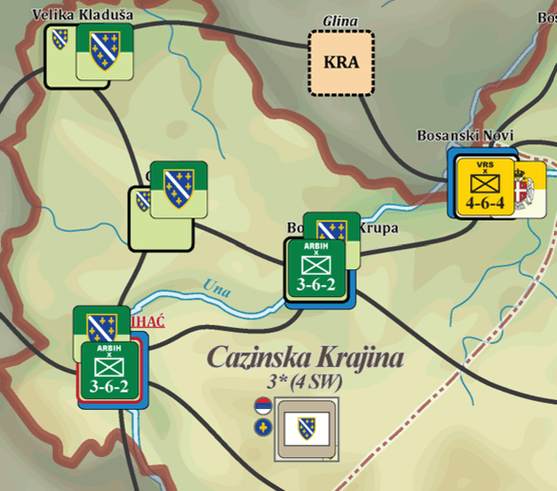
Currently held by the Bosniak player. They control Bihac and 3 other spaces, more than enough to have control over this region and gain the 4 SW. It is also a key region for the Serbians and Bosniaks (the two symbols next to the control marker). In order for the Serbians to switch control, they would have to take Bihac and one other space (they control one space in Bosanski Novi). If the Serbs pull this off, they would dock the Bosniaks 4 SW and add 4 SW to their total. A side note that I did not cover in much detail, if the Serbians take Bihac, they also drop one level on the FA track as well since that space is a “Key Space captured” for FA impacts.
Again, this is perhaps the hardest part of the game. The players will have to pay close attention to the Player Aids to make sure they fight over the correct terrain. From the above example, not much point in the Croats sending any troops to this region as they get no points either way. They could prevent someone else from making hay here, but the Croatian grass is much greener in other fields.
Supply
What is a wargame without supply? In this game it’s straightforward –
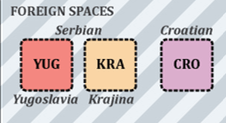
Serbians must trace to an outside Bosnia territory of the first 2 colors (Krajina MAY be only for troops from the Krajina pool, not 100% sure), while the Croatians and Bosniaks must trace to the purple Croatian spaces (going to get a bit mind warping when the Bosniaks and Croats fight each other as they can’t block each other). In the likely event that forces do get cut off (that Cazinska Krajina area above is a real sore thumb for the Bosniaks as all the neighboring Foreign Spaces are all Serbian; this place should always have a supply issue), then your supply is tied to the number of Key spaces you have in your pocket. Each Key Space can support 3 units; any excess units will be tagged with Low Supply.
The supply issue will only get worse as if they remain unsupplied for multiple rounds of your actions, they will degrade to eventually getting removed from play all together (like out of the force pool never to return). Be very careful with your supply; it’s not as brutal as PoG, but it’s still quite rough.
Foreign Troops
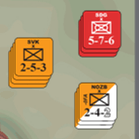
Each side has a selection of foreign forces they can bring to the battle (the Serbs have a few flavors of them). They pack a bigger punch than your regulars (well, maybe not the Krajinas pictured here, but in general). They come into play via event cards and also carry some FA impact when they deploy. Use them carefully to avoid drawing the ire of the foreign community.
Lastly – welcome the city of Sarajevo!
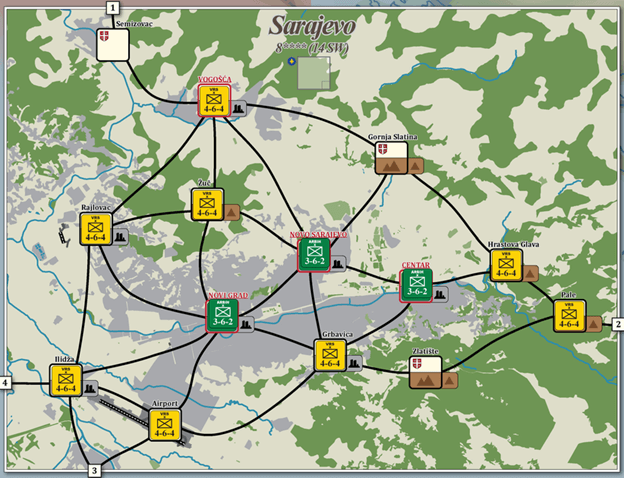
Not going to say too much about it, as I like to leave a brain tickler and something to entice the reader to get the game. Let’s leave it at – the fate of the city was critical to the whole war and merited a submap to the game to capture the influence.
Note the 14 pt SW swing against the Bosniaks if the Serbs wrestle control away. Now this is NOT a key region for the Serbian win, but they do still get the 14 pts. The Bosniaks must control it to net an immediate win (the side that gains all the victory condition SW pts and control ALL their Key Regions wins outright with no need to figure out the final Victory Score). For now, a bit of a teaser. Do note the brutal terrain in an area that has some rough fighting areas to begin with.
Hope you all enjoyed this sneak peek into Brotherhood and Unity. I enjoyed the game a great deal and have enjoyed my exchanges with the designer Tomislav immensely (is that region Tomislavigrad named after a famous family member of his?). For the folks looking for an easy to get into 3 player (!?) PoG like game to get into, do check this one out. You will also get wonderful insight into why the Balkans region is such a difficult region for historians to sort out. Enjoy!
Very interesting! Thanks for the article.